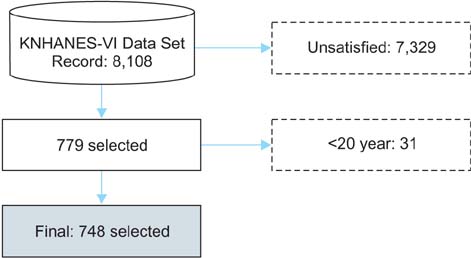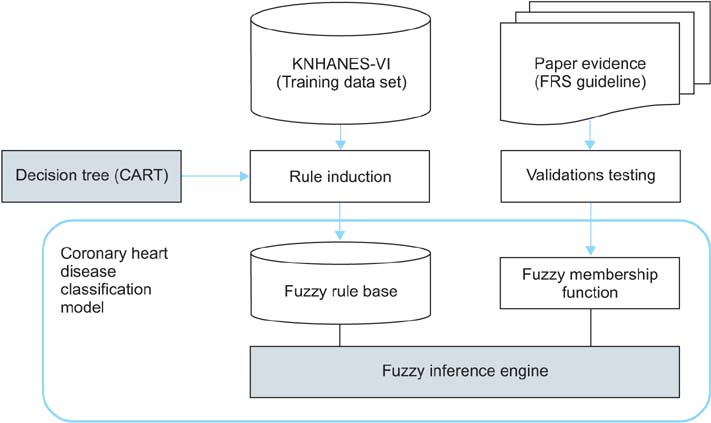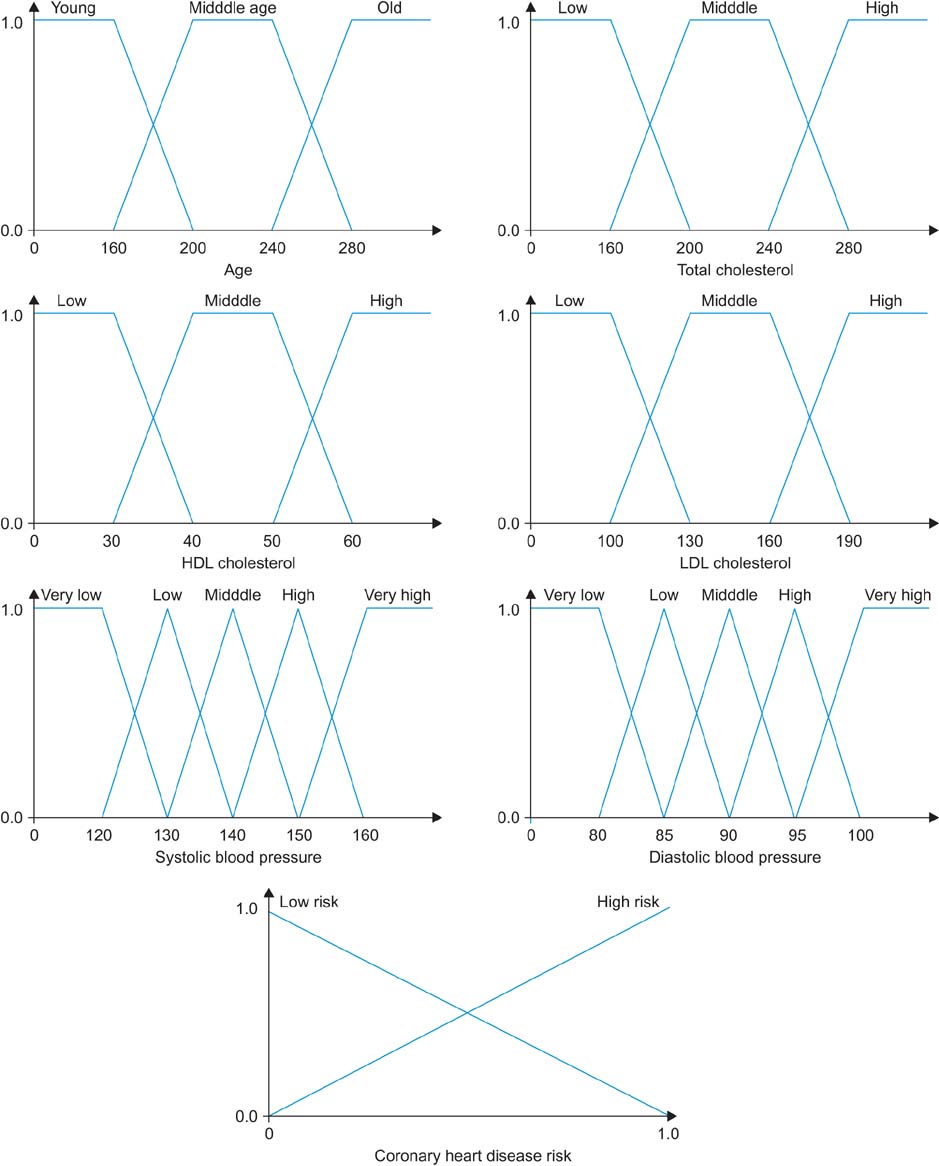Healthc Inform Res.
2015 Jul;21(3):167-174. 10.4258/hir.2015.21.3.167.
Data-Mining-Based Coronary Heart Disease Risk Prediction Model Using Fuzzy Logic and Decision Tree
- Affiliations
-
- 1Department of Computer and Information Engineering, Inha University, Incheon, Korea.
- 2IT Department, Gachon University, Seongnam, Korea. lyh@gachon.ac.kr
- KMID: 2125185
- DOI: http://doi.org/10.4258/hir.2015.21.3.167
Abstract
OBJECTIVES
The importance of the prediction of coronary heart disease (CHD) has been recognized in Korea; however, few studies have been conducted in this area. Therefore, it is necessary to develop a method for the prediction and classification of CHD in Koreans.
METHODS
A model for CHD prediction must be designed according to rule-based guidelines. In this study, a fuzzy logic and decision tree (classification and regression tree [CART])-driven CHD prediction model was developed for Koreans. Datasets derived from the Korean National Health and Nutrition Examination Survey VI (KNHANES-VI) were utilized to generate the proposed model.
RESULTS
The rules were generated using a decision tree technique, and fuzzy logic was applied to overcome problems associated with uncertainty in CHD prediction.
CONCLUSIONS
The accuracy and receiver operating characteristic (ROC) curve values of the propose systems were 69.51% and 0.594, proving that the proposed methods were more efficient than other models.
Keyword
MeSH Terms
Figure
Cited by 2 articles
-
Interpretation of Clinical Data Based on C4.5 Algorithm for the Diagnosis of Coronary Heart Disease
Wiharto Wiharto, Hari Kusnanto, Herianto Herianto
Healthc Inform Res. 2016;22(3):186-195. doi: 10.4258/hir.2016.22.3.186.Intelligence System for Diagnosis Level of Coronary Heart Disease with K-Star Algorithm
Wiharto Wiharto, Hari Kusnanto, Herianto Herianto
Healthc Inform Res. 2016;22(1):30-38. doi: 10.4258/hir.2016.22.1.30.
Reference
-
1. World Health Organization. The world health report 2010 [Internet]. Geneva, Switzerland: World Health Organization;c2015. cited at 2015 Jul 1. Available from: http://www.who.int/whr/2010/en/.2. Liu K, Daviglus ML, Loria CM, Colangelo LA, Spring B, Moller AC, et al. Healthy lifestyle through young adulthood and the presence of low cardiovascular disease risk profile in middle age: the Coronary Artery Risk Development in (Young) Adults (CARDIA) study. Circulation. 2012; 125(8):996–1004.
Article3. Wilson PW, D'Agostino RB, Levy D, Belanger AM, Silbershatz H, Kannel WB. Prediction of coronary heart disease using risk factor categories. Circulation. 1998; 97(18):1837–1847.
Article4. Lee DY, Rhee EJ, Choi ES, Kim JH, Won JC, Park CY, et al. Comparison of the predictability of cardiovascular disease risk according to different metabolic syndrome criteria of American Heart Association/National Heart, Lung, and Blood Institute and International Diabetes Federation in Korean men. Korean Diabetes J. 2008; 32(4):317–327.
Article5. Kim JK, Lee JS, Park DK, Lim YS, Lee YH, Jung EY. Adaptive mining prediction model for content recommendation to coronary heart disease patients. Cluster Comput. 2014; 17(3):881–891.
Article6. Song MH, Kim SH, Park DK, Lee YH. A multi-classifier based guideline sentence classification system. Healthc Inform Res. 2011; 17(4):224–231.
Article7. Hachesu PR, Ahmadi M, Alizadeh S, Sadoughi F. Use of data mining techniques to determine and predict length of stay of cardiac patients. Healthc Inform Res. 2013; 19(2):121–129.
Article8. Palaniappan S, Awang R. Intelligent heart disease prediction system using data mining techniques. In : Proceedings of IEEE/ACS International Conference on Computer Systems and Applications (AICCSA2008); 2008 Mar 31-Apr 4; Doha, Qatar. p. 108–115.9. Anooj PK. Clinical decision support system: risk level prediction of heart disease using decision tree fuzzy rules. Int J Res Rev Comput Sci. 2012; 3(3):1659–1667.10. Khatibi V, Montazer GA. A fuzzy-evidential hybrid inference engine for coronary heart disease risk assessment. Expert Syst Appl. 2010; 37(12):8536–8542.
Article11. Krishnaiah V, Narsimha G, Chandra NS. Heart disease prediction system using data mining technique by fuzzy K-NN approach. In : Satapathy SC, Govardhan A, Srujan Raju K, Mandal JK, editors. Emerging ICT for bridging the future: Proceedings of the 49th Annual Convention of the Computer Society of India (CSI). Cham, Switzerland: Springer International Publishing;2015. p. 371–384.12. Jung H, Yang J, Woo JI, Lee BM, Ouyang J, Chung K, Lee Y. Evolutionary rule decision using similarity based associative chronic disease patients. Cluster Comput. 2014; 18(1):279–291.
Article13. Barman M, Choudhury JP. A fuzzy rule base system for the diagnosis of heart disease. Int J Comput Appl. 2012; 57(7):46–53.14. Papageorgiou EI. A new methodology for decisions in medical informatics using fuzzy cognitive maps based on fuzzy rule-extraction techniques. Appl Soft Comput. 2011; 11(1):500–513.
Article15. Kim JK, Son EJ, Lee YH, Park DK. Decision tree driven rule induction for heart disease prediction model: Korean National Health and Nutrition Examinations Survey V-1. In : Kim KJ, Chung KY, editors. IT Convergence and Security 2012. Amsterdam: Springer Netherlands;2013. p. 1015–1020.16. Korea Center for Disease Control and Prevention. The 6th Korea National Health & Nutrition Examination Survey 2013 (KNHANES VI) [Internet]. Cheongju: Korea Center for Disease Control and Prevention;c2015. cited 2015 Jul 1. Available from: http://knhanes.cdc.go.kr/.17. Park M, Kim H, Kim SK. Knowledge discovery in a community data set: malnutrition among the elderly. Healthc Inform Res. 2014; 20(1):30–38.
Article18. Son EJ, Kim JK, Lee YH, Jung EY. Data Mining-Driven Chronic Heart Disease for Clinical Decision Support System Architecture in Korea. In : Kim KJ, Chung KY, editors. IT Convergence and Security 2012. Amsterdam: Springer Netherlands;2013. p. 1021–1025.19. Zhu W, Zeng N, Wang N. Sensitivity, specificity, accuracy, associated confidence interval and ROC analysis with practical SAS implementations. In : Proceedings of Northeast SAS Users Group (NESUG) 2010: Health Care and Life Sciences; 2010 Nov 14-17; Baltimore, MD. p. 1–9.20. Akay M. Noninvasive diagnosis of coronary artery disease using a neural network algorithm. Biol Cybern. 1992; 67(4):361–367.
Article21. Sengur A. Support vector machine ensembles for intelligent diagnosis of valvular heart disease. J Med Syst. 2012; 36(4):2649–2655.
Article22. Laurent S, Boutouyrie P, Asmar R, Gautier I, Laloux B, Guize L, et al. Aortic stiffness is an independent predictor of all-cause and cardiovascular mortality in hypertensive patients. Hypertension. 2001; 37(5):1236–1241.
Article23. Freund Y, Mason L. The alternating decision tree learning algorithm. In : Proceedings of the 16th International Conference on Machine Learning (ICML'99); 1999 Jun 27-30; Bled, Slovenia. p. 124–133.
- Full Text Links
- Actions
-
Cited
- CITED
-
- Close
- Share
- Similar articles
-
- Application of Fuzzy Logic for Predicting of Mine Fire in Underground Coal Mine
- Interpretation of Clinical Data Based on C4.5 Algorithm for the Diagnosis of Coronary Heart Disease
- Systematic Review of Data Mining Applications in Patient-Centered Mobile-Based Information Systems
- Predictors of Protective Factors for Internet Game Addiction in Middle School Students using Data Mining Decision Tree Analysis
- Development of a revisit prediction model for the outpatient in a hospital






